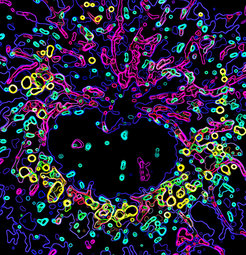The symphony of organelles
With “OrgaPlexing” Max Planck researchers reveal how immune cells organize their intracellular architecture to control inflammatory processes
Scientists at the Max Planck Institute of Immunobiology and Epigenetics have developed a novel imaging method that illuminates how macrophages, key sentinel cells of the immune system, organize their intracellular structures during bacterial infections and inflammation. The technique allows simultaneous observation of interactions between multiple organelles, providing unprecedented insights into the intracellular control of cell metabolism and production of inflammatory molecules. It opens up new perspectives for the research and potentially medical screening of complex diseases such as inflammation, infections and cancer.

Human and animal cells are compartmentalized by several different membrane-bound entities called organelles, each responsible for specific cellular tasks. Until now, it was unclear how the individual organelle systems interact with each other as a whole to orchestrate cellular fate and function together. Now researchers at the Max Planck Institute of Immunobiology and Epigenetics in Freiburg developed a new imaging method, termed OrgaPlexing, which allows them to map the interactome between up to six key organelles and determine functional interactions between them.
Focus on macrophages
The study focused on a critical immune cell population of the innate immune system, the macrophages, which rapidly alter their metabolism to combat infections. Researchers discovered that lipid droplets, crucial fat storage organelles, play a pivotal role in this process. Instead of acting on their own, lipid droplets form intricate units with several other organelles, assisting macrophages in adapting their metabolism.
“We found that macrophages form functional multi-organelle units that consist of the endoplasmic reticulum, mitochondria, lipid droplets, and peroxisomes. Together, they form and regulate a network of lipid flow paths, just like little highways for the production of lipid molecules within the cell, which are crucial for producing inflammatory molecules,” explains Julia Zimmermann, first author of the paper. The study thus shows how several organelles form specific interactions with each other to control fatty acid utilization and the production of inflammatory mediators in macrophages.
OrgaPlexing – Simultaneous visualization of multiple organelles
In the center of the study stands an innovative approach of visualizing and quantifying multiple organelles within individual primary immune cells. “Previous studies of organelle interactions in immune cells have typically focused on pairs of organelles. However, it seemed likely that certain organelles would form more than just pairwise interactions. We therefore developed a method called OrgaPlexing to visualize up to six organelles at the same time and analyze their interactions,” says Angelika Rambold, corresponding author and head of the Laboratory »Organelle Networks in Immunology«.
OrgaPlexing involves staining cells with a panel of different specific reagents, including fluorescent antibodies and dyes, to visualize the respective organelles. Images are then captured using a special microscope that separates the different fluorescence spectra to obtain clear images of up to six different organelles simultaneously. By combining this multi-spectral imaging with advanced 3D image analysis, the Freiburg team has developed a workflow that makes it possible to analyse the mass, morphology, position and interactions of organelles in macrophages over the time course of an inflammatory response.
“We now understand that macrophages dynamically coordinate seemingly separate cellular components as functional units to control their cellular function. The ability to define such units of cooperating organelles allows us new insights into how organelle networks regulate cells. This also changes our view of physiological and pathophysiological processes in which organelles play a role,” says Angelika Rambold.
Powerful tool for studying organelle function
For researchers, OrgaPlexing represents a significant advance – particularly, for work with primary immune cells, where technical limitations previously limited system-wide organelle imaging. The fact that OrgaPlexing does not necessitate genetic manipulation of target cells and can be applied to practically any cell type makes it a powerful tool for studying cellular metabolism and organelle function in healthy and diseased cells.
Angelika Rambold and her team are convinced that OrgaPlexing’s ability to visualize and measure cellular responses at this systems level will improve our understanding of complex diseases such as neuroinflammation, infection and cancer. These diseases are strongly linked to the metabolism and function of organelles.
AR/JZ/MR












